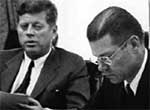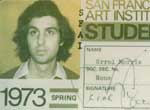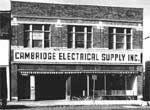Agent Orange: A variety of herbicide that U.S. forces used in Vietnam to kill plants and remove leaves from trees that provided cover for the enemy. The use of Agent Orange was recommended by the Joint Chiefs of Staff and Robert McNamara and approved by President Kennedy in 1961. Between 1961 and 1971, C-123 planes sprayed more than 19 million gallons of Agent Orange and other herbicides in South Vietnam. After the Vietnam War, it was determined that toxins in Agent Orange had caused cancer and birth defects in those exposed to it.
For Further Reading: Operation Ranch Hand: The Air Force and Herbicides in Southeast Asia, 1961-1971 by William A. Buckingham, Jr.
Armistice Day: The worldwide celebration that occurred on November 11th, 1918 to mark the end of World War I, the most devastating war in human history to that point. President Woodrow Wilson and many Americans believed the by winning World War I, they had fought the war to end all wars. Only two years old at the time, Robert McNamara remembers attending the Armistice Day celebration in San Francisco.
For Further Reading: Breaking the Heart of the World by John Milton Cooper
Atomic Bombs: From 1939 to 1945, more than $2 billion was spent on the secret enterprise to build an atomic bomb known as the �Manhattan Project.� On August 6th, 1945, a Uranium bomb nicknamed �Little Boy� was dropped on Hiroshima, Japan, instantly killing 80,000 people. Three days later on August 9th, a Plutonium bomb nicknamed �Fat Man� was dropped on Nagasaki, Japan, instantly killing 58,000 people.
For Further Reading: The Making of the Atomic Bomb by Richard Rhodes.
B-29 Superfortress: The U.S. Air Force's heavy, long-range bomber that went into service in the fall of 1944. It was the most complex machine ever constructed. Capable of flying at over 30,000 feet with a range of 6,000 miles, the B-29 was used for the devastating firebombing of Japan as well as for dropping the two atomic bombs on Japans in 1945. In the fall of 1943, Robert McNamara was sent from the 8th Air Force in London to Salina, Kansas to help ameliorate construction delays on the first B-29s coming into service - the 58th bomb wing.
For Further Reading: Superfortress: The B-29 and American Air Power by Curtis E. LeMay and Bill Yenne.
Bay of Pigs: The invasion of communist Cuba in April, 1961 by a band of U.S. trained Cuban exiles. The exiles were intended to infiltrate Cuba and incite an uprising that would overthrow Fidel Castro. All of President Kennedy's civilian and military advisors - with the exception of Congressman Richard Fulbright - gave their approval for the invasion. However, without U.S. aerial support - which was denied by President John Kennedy - the mission was a complete disaster both militarily and politically for the Kennedy administration.
For Further Reading: Politics of Illusion: The Bay of Pigs Invasion Reexamined by James Blight and Peter Kornbluh.
Cuban missile crisis: The closest the United States and Soviet Union ever came to nuclear war. On October 16th, 1962, the U.S. determined that the Soviet Union had secretly smuggled nuclear missiles into Cuba. On the recommendation of Robert McNamara, the U.S. initiated a naval blockade of Cuba and made preparations for air strikes and an invasion of Cuba. On October 28th, Soviet Premier Nikita Khrushchev publicly announced that he would remove Soviet missiles from Cuba, ending the standoff. Robert McNamara learned from Fidel Castro in 1989 that nuclear warheads for the missiles were already in Cuba at the time of the crisis, and had the U.S. invaded, the nuclear missiles would have been used against both the U.S. invading force and mainland United States.
For Further Reading: The Cuban Missile Crisis, 1962 edited by Laurence Chang and Peter Kornbluh.
Curtis LeMay: Born in Columbus, Ohio in 1906. LeMay joined the U.S. Army Air Corps in 1928 and by 1942 had been given command of the 305 bombardment group of the 8th Air Force in London. As commander of one of the first 4 bomb groups to bomb Germany, LeMay received recognition for his training innovations and development of new bombing techniques. In 1944 he left Europe for China to take command of the 20th Bomber Command, which began striking targets in Japan. In January, 1945, he replaced Haywood Hansell as commander of the 21st Bomber Command, a newer and larger command of B-29 bombers that was stationed on the Marianas Islands. From there, LeMay planned and conducted a devastating bombing campaign of Japan. In March of 1945, he devised a tactic low-level, nighttime incendiary bombing that eventually would destroy 67 Japanese cities and kill nearly one million civilians. LeMay's command was further responsible for the dropping of the two atomic bombs on Hiroshima and Nagasaki in August, 1945. In 1948, LeMay took command of the Strategic Air Command, the nation's strategic nuclear defense command. In 1961, President Kennedy named him Chief of Staff of the Air Force, where he repeatedly clashed with Secretary McNamara on strategy, weapons, and budgets. He retired as Chief of Staff in 1965, and in 1968 ran for Vice-President with Governor George Wallace on the American Independent Party Ticket. They lost and LeMay again returned to private life.
For Further Reading: Iron Eagle: The Turbulent Life of General Curtis LeMay by Thomas M. Coffey.
Domino Theory: The concept that if one country becomes Communist, its neighboring nations will mostly likely follow. The theory was first expressed by President Dwight Eisenhower in 1954 and was used by subsequent U.S. administrations to justify the war in Vietnam. Many historians, as well as Robert McNamara, now believe that had the U.S. not intervened in South Vietnam, all of Asia would not have fallen under communist control and the security of the West would not have been affected.
For Further Reading: A Grand Delusion: America's Descent into Vietnam by Robert Mann.
Diem Assassination: On November 1st, 1963, South Vietnamese President Ngo Dinh Diem and his brother were assassinated in a military coup supported by the Kennedy Administration. After the coup, South Vietnam never again had a stable government until the end of the Vietnam War. This instability led to an increased U.S. military involvement to buttress the subsequent South Vietnam governments, which had little success in suppressing the North Vietnamese insurgents without U.S. assistance.
For Further Reading: Death of a Generation: How the Assassination of Diem and JFK Prolonged the Vietnam War by Howard Jones.
Firebombing of Japan: For the first three years of World War II, The U.S. Air Force, conducted high-altitude, daylight, precision bombing of Nazi Germany and Japan. Due to the presence of high winds and cloud cover over Japan, the Air Force began a devastating campaign of nighttime, low-level firebombing of Japan on the night of March 10th, 1945 in Tokyo. In that single night, 334 B-29 bombers burned to death nearly 100,000 civilians in Tokyo. In the ensuing five months, the U.S. would firebomb 66 additional Japanese cities, killing nearly a million Japanese civilians, injuring over 1.3 million, and causing nearly one quarter of the Japanese urban population to evacuate their homes. Robert McNamara was the Statistical Control Officer for the 20th Air Force, which was the bomber command responsible for both the firebombing and the dropping of the atomic bombs on Japan. McNamara's memorandum on the inefficiency of the bombing operations contributed to General Curtis LeMay's decision to begin a firebombing campaign.
For Further Reading: The Rise of American Air Power: The Creation of Armageddon by Michael S. Sherry.
Great Depression: The calamitous, worldwide economic collapse of the 1930s that at its height saw 25% of the country's work force (13 million people) unemployed. Beginning with the 1929 stock market collapse, the Great Depression did not end in the United States until the nation's entry into World War II in 1942. As an undergraduate at Berkeley from 1933 to 1937, Robert McNamara and many other students became economic majors in response to the economic devastation of the Great Depression.
For Further Reading: The Great Depression: America 1929-1941 by Robert McElvaine.
Gulf of Tonkin Incidents: On August 2, 1964, the American destroyer Maddox was attacked by North Vietnamese patrol boats. On August 4th, the destroyers Maddox and Turner Joy reported that they were being attacked by North Vietnamese patrol boats. By the end of the day, President Lyndon Johnson had ordered the first U.S. air strikes of North Vietnam in retaliation. And on August 7th, Congress passed The Tonkin Gulf Resolution, which gave the President authority to take the nation to war. Almost immediately after the attack on August 4th, evidence arose that the attack may not have taken place. In a 1995 meeting with retired Vietnamese General Vo Nguyen Giap, Robert McNamara was told definitively that the attack on August 4th never occurred.
For Further Reading: Tonkin Gulf and the Escalation of the Vietnam War by Edwin Moise.
Ho Chi Minh: The founder and President of the Democratic Republic of Vietnam (also known as North Vietnam). He was born in 1890 and joined the French Communist Party in 1920, and later formed the Indochinese Communist Party in the early 1930s. In 1941, he founded an alliance known as the Vietminh to fight the French occupation of Vietnam. After the defeat of France at the battle of Dien Bien Phu, the Geneva Accords of 1954 divided Vietnam into North and South at the 17th Parallel. Ho Chi Minh was determined to unify Vietnam under communist control. After years of supporting insurgency in South Vietnam, Ho Chi Minh ordered regular units of the Democratic Republic of Vietnam into South Vietnam in 1964. The United States responded by beginning its Rolling Thunder bombing campaign against North Vietnam in March, 1965 and by the summer of 1965 had greatly increased its troop deployment. The first major battle between U.S. and DRV forces occurred at the battle of Ia Drang in November, 1965. Ho Chi Minh continued his fight for Vietnamese unification against South Vietnam and the United States until his death in 1969. Vietnam was finally unified in 1975 and the capitol of South Vietnam, Saigon, was renamed Ho Chi Minh City.
For Further Reading: Ho Chi Minh: A Life by William Duiker
JFK Assassination: President John F. Kennedy was assassinated in Dallas, Texas on November 22nd, 1963. Vice-President Lyndon B. Johnson succeeded him as the 36th President of the United States. Robert McNamara was responsible for choosing Kennedy's burial spot at Arlington Cemetery in Virginia. After the assassination, Kennedy and McNamara's plan for removing all U.S. military advisors from Vietnam was scuttled by Lyndon Johnson, who reaffirmed the U.S.'s commitment to South Vietnam in a National Security Memorandum only four days after he took office.
For Further Reading: An Unfinished Life: John F. Kennedy, 1917-1963 by Robert Dallek.
JFK Presidential Recordings: In the summer of 1962, President John F. Kennedy installed a clandestine taping machine in the Cabinet Room of the White House to record meetings. Before his death, Kennedy recorded approximately 250 hours of meetings as well as 12 hours of telephone conversations. The most memorable recordings take place during the Cuban missile crisis in October, 1962. These recordings provide intimate details into how the U.S. government works during moments of crisis.
For Further Reading: The Presidential Recordings of John F. Kennedy, Volumes 1-3, The Great Crises edited by Philip Zelikow and Ernest May.
LBJ Telephone Conversations: Between November 22, 1963 and January, 1969, President Lyndon Johnson covertly recorded telephone conversations from the Oval Office and his Texas ranch. The first of the recordings were released to the public in 1993 in conjunction with the JFK Assassination Records Collection Act. The last three years of the recordings have yet to be released.
For Further Reading: Taking Charge: The Johnson White House Tapes, 1963-1964 and Reaching for Glory: Lyndon Johnson's Secret White House Tapes, 1964-1965 edited by Michael Beschloss.
March on the Pentagon: On October 21, 1967, 50,000 people convened on the Mall in Washington D.C. in the largest demonstration against the Vietnam War to that point. 20,000 from that group marched on the Pentagon in an attempt to shut down Pentagon operations. Robert McNamara was responsible for coordinating the defense of the Pentagon and was able to prevent the demonstrators from entering the Pentagon.
For Further Reading: Armies of the Night: History as a Novel, the Novel as History by Norman Mailer.
Marianas Islands: A South Pacific island chain that U.S. forces captured from the Japanese in the summer of 1944 during World War II. The 20th Air Force used the islands of Guam, Saipan, and Tinian to conduct its aerial bombing campaign of Japan.
Napalm: The highly flammable, jellied gasoline substance that was created by the Harvard chemist, Louis Fieser, in 1942. Napalm was used by the U.S. Air Force to firebomb 67 Japanese cities during the spring and summer of1945. It was later used during the Korean and Vietnam Wars.
For Further Reading: Blankets of Fire: U.S. Bombers over Japan during World War II by Kenneth Werrell.
Norman Morrison: A Quaker who burned himself to death outside of Robert McNamara's office at the Pentagon on November 2nd, 1965 in protest of the war in Vietnam.
For Further Reading: Living and the Dead: Robert McNamara and Five Lives of a Lost War by Paul Hendrickson.
Rolling Thunder: The sustained campaign of aerial bombardment that the United States Air Force initiated against North Vietnam in March of 1965. Between 1965 and 1968, the Air Force dropped over 1.5 million tons of bombs on North Vietnam in connection with Rolling Thunder. The hope of certain members of the Johnson administration, including Robert McNamara, was to make it clear to Ho Chi Minh and the North Vietnamese leadership that they should cease support of the Vietcong insurgents in South Vietnam and come to a settlement instead of facing continued aerial devastation. However, despite the tremendous damage and casualties inflicted by the Rolling Thunder bombing program, the North Vietnamese refused to stop supporting the insurgency in South Vietnam.
For Further Reading: American Tragedy: Kennedy, Johnson, and the Origins of the Vietnam War by David Kaiser.
Secretary of Defense: The position of Secretary of Defense was created after World War II in 1947 in an attempt to bring the military branches under civilian control. Robert McNamara became the 8th Secretary of Defense of the United States on January 20th, 1961. He would serve under both Presidents Kennedy and Johnson before leaving office on February 29th, 1968.
For Further Reading: Decisions of Robert S. McNamara: A Study of the Role of the Secretary of Defense by James Roherty.
Statistical Control: A new division of the U.S. Air Force that came into existence in 1942. Statistical Control Officers were trained at Harvard Business School and then assigned to every Air Force command where worked to apply standardized procedures to statistical reporting and analysis. They served to organize the movement of men, planes, and materiel, as well as provide statistical analysis of bombing missions. This data was used by Air Force commanders of as an essential factor in planning and the quantitative measure of achievement. Robert McNamara was one the original faculty members of the Statistical Control School at Harvard, and then served as a Statistical Control Officer for the 8th Air Force in London and then the 20th Air Force in India, China, and the Marianas.
Vietcong: The colloquial term for the North Vietnamese-sponsored, communist insurgents who were fighting the South Vietnamese government. The Vietcong were formally known as the National Liberation Front.
1960 Presidential Election: Senator John F. Kennedy defeated Vice-President Richard Nixon to become the 35th President of the United States. Although Kennedy won the electoral vote 303 to 219, he only received 118,000 more votes than Nixon in the popular vote.
1964 Presidential Election: President Johnson was opposed by the ultra-conservative, Republican Senator Barry Goldwater. Johnson easily won reelection as Senator Goldwater's public support for the use of nuclear weapons in Vietnam helped President Johnson win 65% of the popular vote, the largest Presidential victory in American history.
The Fog of War: Glossary
MORE FOG OF WAR
Official website
Synopsis
Watch Clip
Transcript
Storyboards
Academy Awards Acceptance Speech
McNamara Gallery
B-29 Cluster Layout
'Fog of War' vs. 'Stop the Presses' (Argument)
Ounce Of Preventive War, Pound Of Destruction (Editorial)
REVIEWS
Todd McCarthy
Fred Kaplan
Samantha Power
Ron Rosenbaum
Kenneth Turan
BUY THIS MOVIE
Amazon
OTHER FILMS
Gates of Heaven
Vernon, Florida
The Thin Blue Line
A Brief History of Time
Fast, Cheap & Out of Control
Mr. Death
Standard Operating Procedure
Tabloid
The Unknown Known
The B-Side
Wormwood
American Dharma






